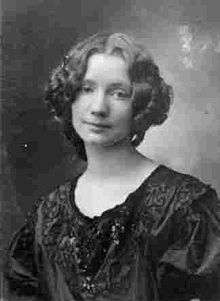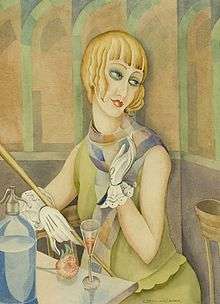Gerda Wegener
| Gerda Wegener | |
|---|---|
 Wegener in 1904 | |
| Born |
Gerda Marie Fredrikke Gottlieb 15 March 1886 Hammelev (town of Haderslev), Denmark |
| Died |
28 July 1940 (aged 54) Frederiksberg, Denmark |
| Occupation | artist, illustrator, painter |
| Spouse(s) |
Lili Elbe (1904-1930; marriage annulled) Fernando Porta (1931-1936; divorced) |
Gerda Marie Fredrikke Wegener (née Gottlieb; 15 March 1886 – 28 July 1940) was a Danish illustrator and painter. Her artwork largely contains images of fashionable women in the style of art nouveau and later art deco.
Early life
Gottlieb grew up in the provinces, in the village of Hammelev near the city of Grenaa, the daughter of Justine (née Østerberg) and Emil Gottlieb, a vicar in the Lutheran church. Her father had Huguenot ancestry and her family was conservative. She had three siblings but was the only child to live to adulthood. She showed artistic talent at a young age and began training. Her family moved to Hobro and later she moved to Copenhagen to pursue her education at the Royal Danish Academy of Fine Arts.
Career
Her career as an artist began after graduating from the Academy in 1907 and 1908 when she won a drawing contest put on by the Politiken newspaper. She then was the center of a controversy called the Peasant Painter Dispute after one of her works, a portrait of Ellen von Kohl, was rejected for exhibitions due to the style of the piece.[1]
She was inspired by fashion, and sought work as an illustrator for Vogue, La Vie Parisienne and other magazines. She became a well-known artist in Paris, but was less successful in Denmark, where people found her work controversial. She held exhibitions of her work at popular art studios around Europe. In 1925, she won a prize for her artwork in competition at the 1925 World Fair in Paris.[2] She was known for her illustrations created for advertisements and was also a sought-after portrait painter. She befriended Ulla Poulsen (1905-2001), a famous Danish ballerina, who became a frequent model for her paintings. She and her spouse were also close friends with artist Rudolph Tegner and his wife Elna.
Lili Elbe

She met fellow artist Lili Elbe (then known as Einar Wegener, and identified as male) at art school.[3] They married in 1904, when she was 18 and her spouse was 22.[4] They traveled through Italy and France, eventually settling in Paris in 1912. The couple immersed themselves in the Bohemian lifestyle of the time, befriending many artists, dancers and other figures from the artistic world, often attending carnivals and other public festivals.
At the time, many considered Lili Elbe to be the more talented artist, but she toned down her own work and profile to help her wife in her artistic endeavors. During this time Elbe began to wear female clothing, and adopted her female name and persona,[5] becoming Gerda Wegener's favorite model, in paintings of beautiful women with haunting almond-shaped eyes dressed in chic fashions. In 1913, the art world was shocked when they learned that the model who had inspired her depictions of petite femmes fatales was in fact her spouse.[4]
As Elbe adopted her female identity, Gerda Wegener commonly introduced her as Einar Wegener's cousin when she was dressed in female attire.[6] In 1930 Elbe underwent sex reassignment surgery (the second known). As Danish law at the time did not recognize marriage between two women, their marriage was annulled in October 1930 by King Christian X. Elbe died in 1931 from complications of the surgery.
Later life and death
In 1931, devastated by Elbe's death, Wegener married Italian officer, aviator, and diplomat Major Fernando Porta, who was ten years her junior, and moved with him to Morocco (specifically Marrakech and Casablanca). She continued to create art during this period, signing her paintings as "Gerda Wegener Porta". She divorced Porta in 1936 after a rocky marriage, with him swindling her funds, and returned to Denmark in 1938. She held her last exhibition in 1939, but by this time, her artwork was out of style. She had no children, and lived alone in relative obscurity, and began to drink heavily. She kept an income by selling hand-painted postcards.
She died on July 28, 1940, in Frederiksberg, Denmark, shortly after Nazi Germany invaded the country.[4] Her small estate was auctioned off, and there was only a small obituary printed in the local paper. Some reports claim she married Einar Wegener because they were both homosexuals, and they knew that in order to find work at that time, they needed to keep this a secret.
Book and film
Over the years, the story of the couple gained a cult following in Denmark and around the world. Their artwork has been rediscovered, and exhibited and auctioned with success. A special exhibition of Gerda Wegener's art is on display at the Arken Museum of Modern Art until January 2017, with plans for a traveling exhibit of her art to travel around the world.[7]
The Danish Girl, David Ebershoff's 2000 novel about them was an international bestseller and was translated into a dozen languages. Gerda Wegener is portrayed by Swedish actress Alicia Vikander in the 2015 film The Danish Girl, also starring British actor Eddie Redmayne as Lili Elbe. The film received some criticism for obscuring the actual story of a historical trans person and omitting certain facts[8] and for being based on a fictional book that does not tell the true story of Einar and Gerda Wegener.[9] The topic of Gerda Wegener's own sexuality, which many believe is demonstrated by the subjects of her erotic drawings, is not mentioned in the film or book.[10][11][12]
Select works illustrated by Wegener
- Le Livre des Vikings by Charles Guyot (1920 or 1924)
- Une Aventure d'Amour à Venise by Giacomo Casanova. Le Livre du Bibliophile. Georges Briffaut. Collection Le Livre du Bibliophile. Paris. 1927.
- Les Contes by La Fontaine (1928-1929).
- Contes de mon Père le Jars and Sur Talons rouges by Eric Allatini (1929)
- Fortunio by Théophile Gautier (1934)
- L'Anneau ou La Jeune Fille Imprudente by Louis de Robert
- Amour Etrusque by J.-H. Rosny aîné
- L'Abdication de Ris-Orangis by Léo Larguier (1918)
References
- ↑ ARKEN Museum of Modern Art. "Catalogue extract (UK): GERDA WEGENER". Issuu.
- ↑ Biography at theguardian.com, accessed 12-15-2015
- ↑ "Conway's Vintage Treasures". Vintage-movie-poster.com. Retrieved 8 April 2014.
- 1 2 3 She and She: The Marriage of Gerda and Einar Wegener. The Copenhagen Post. 3 July 2000
- ↑ The Arts and Transgender. renaissanceblackpool.org
- ↑ Lili Elbe. andrejkoymasky.com. 17 May 2003
- ↑ Gerda at Arken accessed 12/15-2015
- ↑ ""The Danish Girl" Stretches Frilly Forced-Femme Fantasy Over Actual Trans History". HARLOT Magazine. 2015-11-23. Retrieved 2015-11-25.
- ↑ "The tragic true story behind The Danish Girl". The Telegraph. December 8, 2015. Retrieved December 10, 2015.
- ↑ "The Incredibly True Adventures of Gerda Wegener and Lili Elbe". coilhouse.net. August 3, 2012. Retrieved December 10, 2015.
- ↑ "Reading Group Notes The Danish Girl". allenandunwin.com. Retrieved December 10, 2015.
- ↑ "The Danish Girl vs the True Story of Lili Elbe, Gerda Wegener". historyvshollywood.com. Retrieved December 10, 2015.
Literature
- Man into woman: an authentic record of a change of sex / Lili Elbe ; edited by Niels Hoyer [i.e. E. Harthern] ; translated from the German by H.J. Stenning ; introd. by Norman Haire. - London, Jarrold Publisher's, 1933 (Original Danish ed. published in 1931 under title: Fra mand til kvinde. Later edition: Man into woman: the first sex change, a portrait of Lili Elbe - the true and remarkable transformation of the painter Einar Wegener. - London, Blue Boat Books, 2004.
- Gerda Wegener / edited by Andrea Rygg Karberg ... [et al.]. - Denmark, Arken Museum of Modern Art, 2015.
External links
| Wikimedia Commons has media related to Gerda Wegener. |
- Retrospective exhibition at ARKEN Museum of Modern Art 7 November 2015 to 8 January 2017